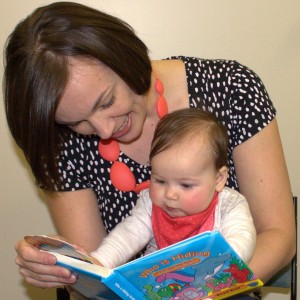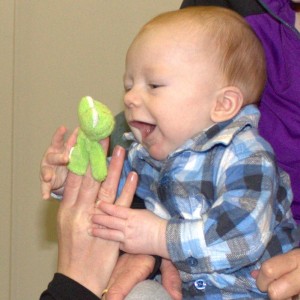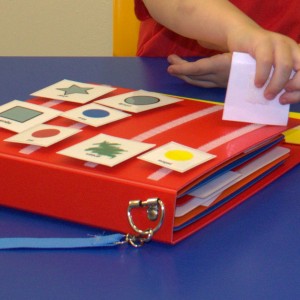 Babies usually begin to use a few simple words at around their first birthday. Most children at around their first birthday can say mum, dad and a couple of other words. New words continue to develop so that by two years of age most children are using between 150 and 300 words. The number of words a child uses continues to grow rapidly through the preschool years and beyond. To see how your child is progressing click here.
Babies usually begin to use a few simple words at around their first birthday. Most children at around their first birthday can say mum, dad and a couple of other words. New words continue to develop so that by two years of age most children are using between 150 and 300 words. The number of words a child uses continues to grow rapidly through the preschool years and beyond. To see how your child is progressing click here.
Some children need extra help to get those first words going.
Four techniques that can help are:
- modelling
- withholding
- sabotaging
- picture exchange
Let's see how each one works.
Modelling helps most children develop these vital early language skills. Model words for your child whenever you do things together. There are a couple of key things to remember when helping your child to learn their first 100 words.
- Keep your model short, just one word is ideal in the beginning so your child can copy you. So instead of saying, “Oh look there’s Nanna’s cat” shorten it right down to “Cat!”
- Use lots of repetition, just saying it once or twice is not going to be enough. Try to say the word 10-15 times.
- Make it lots of fun by using lots of different activities around themes. Common animals, food or transport are a good starting place. Use toys, books, puzzles, real objects and any other ideas you may have with the same vocabulary.
- Imitate sounds made by objects and encourage your child to do so too. Talk about animal noises also eg: “Cow, it goes moo”. Try to use speech sounds when you make the noise of different objects and animals, e.g. a pig goes oink, oink, (not grunts).
- Emphasise short one syllable words, particularly with b, p, m. t, d, n sounds as these are easiest for a young child. Simple farm animals and the sounds they make are ideal.
 Have fun while you:
Have fun while you:
- Name pictures in simple picture books.
- Play games with objects as you name them. Hide them under a tea towel, in a pillow case, in a tissue box or behind your back and “find” them.
- Play lotto, memory, posting and fish with clear and attractive picture cards
- Name things that you see in daily activities such as clothes as you get dressed, food as you feed your child, toys as you pass them or pick them up.
- Play simple games such as "boo" where you repeat the same word over and over, blocks "up, up. up" and bubbles "pop, pop, pop".
What do you do when new words are coming slowly?
How many times do kids hear "You can't have it until you say it first!". This strategy is often used by parents to help kids "use their words". Depending how it is done "withholding" can be an effective strategy to help kids learn to use their words to request and initiate communication; or it can set up a power struggle with a stubborn toddler; or worst still destroy the confidence of a more sensitive one. It all depends on how and when it is done.
Likewise as parents we can all to easily predict what our children want and remove the need to communicate by providing all their needs before they even try to ask. This denies a child important opportunities to practice communicating and develop independence and assertiveness. So how do we find the right balance? Laura Mize in her book series "Teach me to Talk" give some practice guidelines and strategies for using "withholding" and "sabotaging" effectively to develop kids communication skills.
Lets look at withholding first:

Laura describes withholding as "purposefully keeping something away from the child until he says the word to request the object". Laura says this should be done with "pleasant persistence" and direct cues.
Only use withholding with words you know your child can say on their own or can imitate easily. This means that they have used the word a few times, not just once. This technique can then be used to help them learn to use this word spontaneously. New words need to be modeled lots of times until your child can imitate them easily before beginning this technique.
Let look at what this means:
- Hold the object for the child to see.
- Give your child a chance to say the word on their own.
- Model the word for the child to imitate.
- Use direct prompts "tell me.." or "say ..."
- Wait for a response.
- If they attempt the word give them the item and praise their efforts.
- If the attempt is not clear model it clearly for them but still give them the item.
- If they do not attempt, try one or two more times.
- If they still do not attempt the word, model it again and give them the item.
The approach needs to be fun, not "I am going to make you ask for this or else".
Hold out for three to five attempts only, so your child can hear some repetitions, remember the word, maintain attention but not get frustrated. If your child gets frustrated you may need to do less attempts.
If your child tries the word but does not say it perfectly, reward their attempts. If they say a different word such as "more" or "please" you may want to reward that too depending on your child's skills.
Some good activities to practice withholding are:
- highly motivating items such as treats
- toys with lots of pieces such as puzzles, threading, stacking blocks, and posting boxes
- activities which can be repeated over and over such as rolling balls, pushing cars, swings
- activities where the adult needs to do something such as blowing bubbles, peek a boo and tickling games
- making a puppet or stuffed toy do different actions such as jump, eat or pop out and say "boo"
What about sabotaging? This is "setting up a situation or a problem that the child has to solve in order to get what he wants". This means not jumping in an giving a child what they need until they ask. Again it should be done in a fun way, and not a way that makes the child feel like giving up. You might put some things that your child wants out of reach so they have to ask or give them some but not all of the things they need. This technique helps kids learn to take the lead and initiate communication. Again only use this technique when you know your child has a word or sign they can use to ask for the thing they need.

Some ways to use this technique include:
- giving them a cup but not pouring the drink in
- giving them the cereal but not the milk, the toast but not the Vegemite
- giving them a bowl but not a spoon
- giving a toothbrush without toothpaste
- putting a toy up on a shelf or in a clear box
- giving them things that need to be opened but not opening them
- giving them shoes but not socks
- giving paper without pencils, paint without brushes
When you have set up a situation where your child needs to communicate:
- Give your child a chance to say the word on their own.
- Model the word for the child to imitate.
- Use direct prompts "tell me.." or "say ..."
- Wait for a response.
- If they attempt the word give them the item and praise their efforts.
- If the attempt is not clear model it clearly for them but still give them the item.
- If they do not attempt, try one or two more times.
- If they still do not attempt the word, model it again and give them the item.
Remember that communication should be fun and your child needs to feel successful to keep on trying. Using these techniques in fun supportive way can help your child to develop effective communication, independence and assertiveness. To find out more about Laura Mize's work you can visit her website at http://teachmetotalk.com/
What if there are still no words?
Sometimes parents are concerned that their child is not developing as well as others of the same age. They may be told to “wait and see” or that “all children are different, don’t compare and they will catch up when they are ready”. Early intervention with a speech pathologist is however the best way to support children with communication delays to catch up and prevent long term issues with learning, development and socialisation.
 Between 12 and 18 months children typically:
Between 12 and 18 months children typically:
- Babble to themselves and to others, as though they are having a conversation
- Listen to things said to them, and understand some things such as 'no'
- Follow a few simple instructions such as 'get your shoes'
- Identify a few familiar objects when they are named (such as 'show me the ball')
- Use 6 or more recognisable words (words may be unclear, but understood by familiar adults).
- Use an average of 10 words at 15 months to as many as 100 or more between 18 months and 2 years
- Understand many more words than they can say
By two years children typically:
- Tell you what they want with words though many words may not be pronounced correctly.
- Combine two or more words together "want more" and then "I want more"
- Understand two things at a time e.g. "Get the ball and bring it to Daddy"
- Be able to tell people what to do e.g. "no" or "go away".
If you are concerned about your child’s communication or social development a speech pathologist can offer support and advice to help your child catch up and reduce the long term effects of any problems. For more information on how a speech pathologist can support you to help your child communicate browse our website.
How can else you help a child with few or no words?
 Picture exchanging helps children to develop communication by giving an immediate reward for an attempt to communicate. Children learn how to communicate an inner desire, helping them to see the value of communication. The success in having their desires met is usually very motivating and results in children wanting to communicate more. Their frustration is also reduced.
Picture exchanging helps children to develop communication by giving an immediate reward for an attempt to communicate. Children learn how to communicate an inner desire, helping them to see the value of communication. The success in having their desires met is usually very motivating and results in children wanting to communicate more. Their frustration is also reduced.
A picture exchange communication system (PECS) is a form of augmentative and alternative communication (AAC) that uses pictures to support words, to help children communicate.PECS was originally designed especially for children with autism who have delays in speech development, however is used very effectively for children with a range of communication difficulties.
PECS works well with children who don't speak at all or have very limited speech. It reduces frustration and teaches communication. Many children then begin to speak quite quickly, but for those who take longer, or who don't learn to speak, being able to communicate is still very valuable.
PECS also works well for children who "speak" but don't communicate very well. Some children with autism for example may echo what others say, or use randon words out of context, or label things they see but not know how to ask for things they want. PECS helps these children learn the meaning and usefulness of communicating with another person to get their needs met. Because these children can say words they often quickly transfer this ability to communicate with pictures into more meaningful use of spoken words.
To find out more about how PECS can help your child visit the PECS webpage. To find out more about how the Talking Matters team can help your child click here. We provide speech pathology and occupational therapy services to children with a range of needs including autism spectrum disorders.
To find out more about Talking Matters visit us on our website, Facebook page, Twitter, or Pinterest. If you live in Adelaide and would like to discuss how Talking Matters can help your child call our friendly office staff on 08 (08) 8255 7137.
Jo Brenecki
Speech pathologist
Related Blog Posts
If you liked this post you may also like:
Talk with me - about books!
Accessing NDIA for children over 6 years
Painting and collage
Why 20% of kids struggle!



